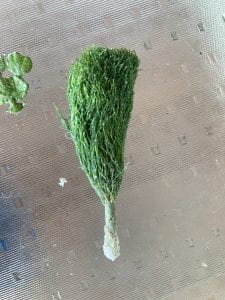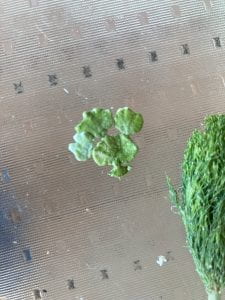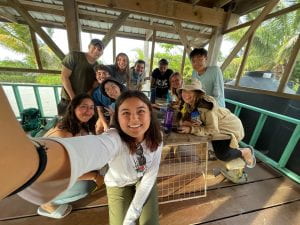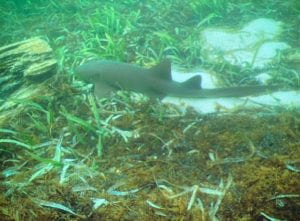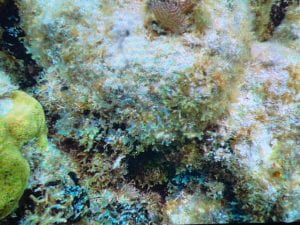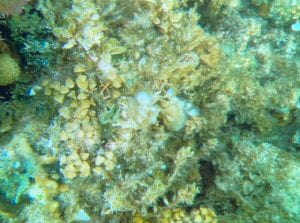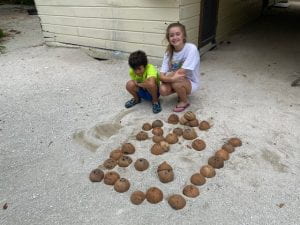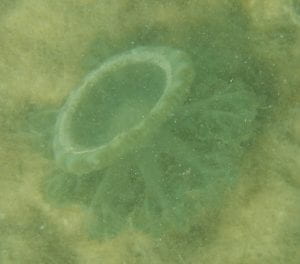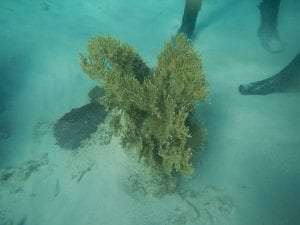I spent the day with my dive buddy Claire today looking for redband parrotfish. We tried to follow them around the reef for a survey on parrotfish diets. At the first site, we didn’t see any. We thought we had found some, but when we got to shore I realized that all I had were videos of wrasses. At the next two sites, we actually did spot a few! Parrotfish are difficult to spot because the same species can look completely different, so it was definitely a challenge. We ended up finding 6 total, but we only saw the two females eat because the males typically patrol and don’t eat as much. On our parrotfish hunt, I also noticed so many christmas tree worms living on brain corals. These guys are so cute!!! If I were to send a wave vibration towards them, they would sense it and shrivel up immediately. Likewise, we played with some sea anemones, who would also shrink up when u got close to them. It was adorable! I also got to see some yellow pencil coral and lettuce coral here!!! The lettuce coral was much smaller than the pictures I have seen. It seemed to grow in small patches around the reef, so I hadn’t noticed it before.
Tag Archives: snorkel
Day 13: MPAyyyee
Today we researched if MPAs vs non-MPAs have a higher species richness and fish abundance based off number of coral species and number of fish and other organisms. We met in the morning to discuss this research project and complete a plan. Once we had our plan down to use quadrants we set off to two non-MPA sites and two MPA sites. In one of the sites we saw jellyfish (we were later informed that these jellies don’t sting). We also saw a dolphin at the last site!
In the afternoon we discussed our results and made a poster. We concluded that MPAs or marine protected areas had a higher species richness and more fish abundance. Visually Zoe and I also noticed that the non-MPAs had way more algae coverage and the coral reefs themselves seemed to look more dead. No eel sightings today.
Day 10: Getting comfortable in the water
Today was our first day of real snorkeling out on the reef. In the morning, we snorkeled right off the dock to make sure we could all comfortably swim and make sure we were comfortable with our gear. After about 15 minutes of practice, we swam out to a patch reef nearby and looked around for a bit. In total, in the morning, we were in the water for around an hour. I was surprised by how exhausting that hour was and how sore I was after. Being in the water for that long took a lot out of me. We also came out salty from the seawater and had to rinse all our gear to ensure that it wouldn’t corrode. It didn’t occur to me that that might happen but I suppose it makes sense. After rinsing our gear and doing a quick debrief, we were released for the morning.
I’m the afternoon, we took a boat maybe 10 minutes away from where we were staying and snorkeled there. It was super shallow and we had to be careful where we were swimming to avoid bumping the reef. The reef itself was super beautiful. We stopped at two locations, and they both were a host to an incredible array of fish and corals. We even saw a nurse shark and some rays! The coral itself was amazing to look at as well—after hearing all about it, I was super glad to be able to recognize some of the hard and soft corals.

I was looking for cryptobenthic fish. Because it was so shallow, I didn’t have to dive far to see them because the reef was so shallow, but I had a really hard time photographing them. Our phones were in these dry bags which protected them from the water, but underwater the touchscreen wouldn’t respond. After talking to some classmates, I eventually learned that you can open the camera app before and then just use the volume button to take pictures. I still had a bit of trouble—at one point, I accidentally took a time lapse, and then I accidentally took a slow-motion video (which caught some fish, but still). I also just had a hard time holding the camera steady and taking clear photos, and even in the clear ones it’s hard to make out the fish. Part of the problem is that they’re so small, well-camouflaged, and near the bottom.

Technical difficulties aside, I did see some of my taxon. The most common cryptobenthic fish I could see are gobies and blennies. They’re both elongate, but gobies tend to be more streamlined while blennies are a little more round and often have . Insterestingly, I was only seeing gobies, and really only one particular genus—Elacatinus. I wonder if that’s because of the habitats or if it has to do with what I was primed or able to see. I’ll find out soon. I’m excited to see what types of experiments and tests we’ll do out here on the reef.
First Snorkel!
After naturally waking up to birds and sun, we got our snorkeling stuff ready for our first trip on the water. Right on the dock, I was struck by the number of fish I could see! There were large fish in close proximity to one another with their fins out of the water, and their was an enormous school of small minor sized fish everywhere! When I got in the water I felt like the whale shark in the aquarium with all the sardines parting around it.
In the reef, we found astounding and dynamic “patch reefs” or structures of chorals, sponges, fish, etc, among the sea of seagrass in the lagoon of the atoll. I was struck by the 3-dimensional variety of shapes and sizes of organisms! Some highlights included seeing a lion fish and a small barracuda.
Dr. Correa also helped me pick a green algae from among the sea grass. I had seen the type of algae she picked but had been initially confused as I thought they were fuzzy spheres on sticks like lollipops. However, they were actually Bristle ball brush algae with rounded tops, a genus called Penicillus I did have on my taxonomic card when we got back! I was able to use the guidebook in the station to identify it as Penicillus Dumetosus mainly through the shape of the top which was much longer than wide and flat on top.
I also saw lots of Halimeda green algae mostly on top of the patch reefs characterized by long chains of roundish segments. Again using the guide books I think it was Halimida goreari as the segments seemed to match the shape and size description best of flattened 2.5-6mm wide segments.
After that we also did a scavenger hunt to practice being in the water with clipboards and cameras in another part of the atoll that was much shallower and sandier. I saw some green algae that appeared to a type of Caulerpa (sea grapes) and Udotea (Mermaid’s fan), but I plan to look at the pictures more closely to get the exact species tomorrow!
Beware the Mangroves of Death
Today was the first snorkeling day!
We started out by snorkeling in the area by the dock, to make sure everyone was comfortable. We then moved to a patch reef further out, and we saw a lot of cool organisms, including some Christmas tree worms, huge brain coral, a corallimorph, some lionfish, and some lobsters. And even more exciting than that-lots of white scroll algae (padina jamaicensis) and sargassum (I did not identify it, but it sure was floating)! Afterwards we came back to the wet lab and constructed quadrats- 3×3 foot pvc pipe frames with strings woven across to form crosshairs. We will be using the quadrats to measure stuff in the field, starting tomorrow.
After lunch we had a vote-either to return to the patch reefs we had gone to this morning, or go to a new area, through the Mangroves of Death (MOD). The professor’s kids (who are along for the ride, I don’t know if I mentioned that) provided a very convincing argument, including the threat of crabs in our rooms if we did not choose the new area. So a landslide vote was probably expected, even considering the risks. We suited up in our snorkeling gear, including our masks, and then ran through the mangrove forest to the reef. At first it was fine, but then we began to feel the pinches of the mosquitoes biting through the dive skin. We had been descended upon by the mosquitoes of the MOD! We ran faster until we finally made it into the water. Not one person was left unbitten.
We then had an enjoyable experience in the patch reef, looking for the organisms or interactions listed on our scavenger hunt pages. Some notable things we saw were a sea urchin and many species of colorful fish.
When we were done, we were presented with the option of either running back through the MOD, or snorkeling. The choice was obvious. While snorkeling back, we saw many orange sponges, some anemones, a yellow ray, and a shark among the sea grass! All around, snorkeling back was the right choice.
We then listened to our classmates present their topics and taxa, and then we split for the night.
Overall, the patch reefs had so much to offer, and I’m looking forward to exploring them more! Also tune in tomorrow, I heard we’re going somewhere deemed “Un-Belizeable!”
-Elena
ps. happy birthday Hugh!!
pps. sorry for the bad photo quality-I can’t easily download the pictures from the digital camera to my computer :'(
picture one is part of the group, picture two is the shark, picture three is y-branched algae (dictyota cyliolata), picture four is white scroll algae (padina jamaicensis) and an unidentified brown algae, and picture five is the kids and their hermit crab empire (under each coconut shell is a hermit crab)!
The First of Many (quadrats)
May 23rd, 2019
So surprise, I figured out that I’m used to having breakfast at 6:00 am (we did most days at Las Cuevas) because I woke up at 6:34 and had a mini heart attack thinking that I was 34 minutes late to breakfast. After my initial panic, I got up for a good breakfast and we started the day in the classroom explaining transect techniques to use when underwater in conjunction with the quadrat (square grid made of pbc pipe and string). To practice, we went to a apart of the island that was littered with dead coral amongst other things, and tallied up the amount of coral vs. other.
After lunch, and waiting for the wind to calm down, we went into the water and swam to nearby seagrass beds to see if we could quantify community changes using quadrats. This involved counting the seagrass, algae, and neither. Once done, the group was asked if we wanted to swim to a patch reef so of course I immediately said yes. Upon approaching the reef, our instructor pointed out a brown Nurse Shark laying under an overhang. After snorkeling around for a but, I began to see some herbivorous fish. I saw a brown Ocean Surgeonfish swimming amongst the coral heads and a bright yellow, juvenile Three Spotted Damselfish, it has single spots on its dorsal, caudal, and tail fins. It looked like it was picking at some algae and seemed to stay on that coral head, which could mean it was tending to an algal garden although this is usually done by adults. It could have just been eating the algae.

We ended the day with presentations on echinoderms (sea stars, brittle stars, sea urchins, and sea cucumbers), red and green algae, and an overview of mangroves and their importance to coral reefs.
Pre-departure blog

After the slog of finals its finally time to head on a two week trip to Belize to the Las Cuevas research station and Glover’s reef. I really hope to see first hand what research in these environments is like, as I’m very interested in eventually pursuing a career in Marine Biology. Furthermore, I’m really interested to see if I can identify rainforest animals with limited resources. I’d also like to learn how to quickly identify an animal in the field using the i.d cards, which I’ve never had to do because I’ve always had access to a database.
I’ve prepared by reading more about the biodiversity of the rainforest as well as trying to identify certain species of birds that I see in my backyard (most of which are house sparrows and robins).
The one thing that I’m nervous about is caving. I’ve never actually been in a cave before so I’m not sure how I’ll react to the confined space or seeing cave crickets. I’ve had some experience in the tropics, mainly snorkeling in the Cayman Islands which are very close to Belize.
I Am Utterly Exhausted
May 22, 2019
Today was a doozy. We had a three hour boat ride to Glover’s Reef this morning. It was a small motor boat speeding across three hours worth of ocean, so it was more like a three hour rollercoaster.
Once we made it to Glover’s, we immediately had a tour of the island, then lunch, and then our first snorkel. We couldn’t stay out for long because the current was strong, but Liz and I made it out to the patch reef, which was beautiful. I’m so excited to go out there again.
Closer to shore, we spotted many upside-down jellyfish (Cassiopeia xamachana) – a scyphozoan from my taxon ID card!!! These jellyfish are particularly interesting because they often rest on the ocean floor upside down with their tentacles in the air such that they look like harmless plants.
We went out again later to a different area of the reef. This area was much more shallow, which made it harder to navigate. This wasn’t ideal because there were many fire coral. I noticed both branching fire coral (Millipore alcicornis) and blade fire coral (Millipore complanate). These hydrozoans are actually not coral at all and can cause a nasty sting with their nematocysts.
Quadrats, not quadrants!
Day 1 of Beach Days, 5/23.
My day began in the savanna cabanas of the tropical education center and it is about to end in a hammock on the Middle Caye of Glover’s Atoll. The view has changed drastically. Compared to the 100 meter visibility in the savanna, my view here at Glover’s is only cut short by the horizons. In this grand view, I see faraway lightning that may be associated with a brewing tropical storm. But because it is likely more than hundreds of miles away, I cannot hear the thunder.
This is our first day at the beach and it has mostly felt like vacation. We travelled to a marina in Belize City to catch a 3-hour boatride to Glover’s. On the way we saw the difference between deep and shallow water, and a myriad of other islands in the area. One constant object I observed was the availability of Sargassum on the ocean surface, some of which were cut up by the motors on our boat. Before I knew exactly what I was looking at, Scott and Jessica yelled out to me asking me to identify the green floating algae. With the amount of intensity and excitement they yelled at me, I understood it must have been something obvious: they are the Sargassum seaweed that has been infesting many coral reef areas, outcompeting many other species of corals and causing their decline. They are a group of brown algae that utilizes fouaxin to photosynthesize which gives them a slightly redder and browner color, although they also have the green pigments that come with chlorophyll. They are also the only species of red and brown algae that has air bladders, allowing them to trap air within the organism.
After arrival, we practiced snorkelling, a follow up to to first practice we had on campus in the recreational pools. This time we were surrounded by bone fish, nurse sharks, stingrays, corals, and jellyfish. The most difficult aspect of this practice was not touching things we should’t touch: corals, stingray and wildlife in general. Compared to the rainforest, where we were able to put our hands on almost anything that we were able to catch, the corals here are very fragile and many animals here are hidden and able to be aroused if touched, such as stingrays. With the construction of marine-use guadrats, we will be exploring and initiating contact with corals and perhaps a Echinoderm or two. The key is to not destroy the wildlife and no let the wildlife destroy us.
Stay tuned to find out how to best place quadrats on corals!

Last Day?
I’m sitting in the pleathery seat of a Southwest flight. It’s certainly strange to not be spending the day in the water. We did this morning, but now, not even being on land, but catapulted into the air, is discombobulating.
This morning’s snorkel was my favorite of the entire trip. We took the boat out with our two amazing tour guides (Herbie and Javier) to Twin Peaks. This is the name of a caye that is made up of mangroves and is separated into two pieces by a sea inlet. We walked through a portion of the land. This was quite difficult due to uneven ground hidden under a layer of seawater. We were falling into holes left and right. I fell in one that went all the up to my mid-thigh.
The best part, however, was when we got to snorkel through the inlet. I was shocked as to the community complexity that was happening on the roots of the red mangrove trees. (Unfortunately, the reign of the soft corals was over. I didn’t see any today.) The sponge symbiosis was so obvious. It was amazing to see something that was mentioned in both a taxonomic briefing and a topic lecture actually flourishing out in the field. The fact that the mangrove is an understudied ecosystem makes me even more interested in it. What if I end up there, studying evolution?
Our other stop of the day made the idea of continuing my studies out in Belize that much more attractive. We visited the Smithsonian research station. Despite being on an island that is only an acre, the facilities were beautiful. I can definitely see myself returning in some capacity. At the same time, there is so much of the world to be examined under the lens of evolution.


